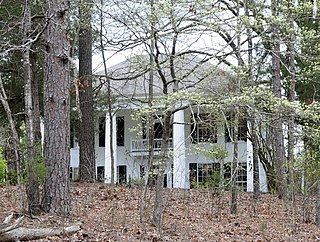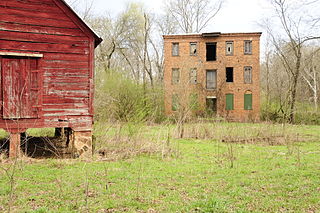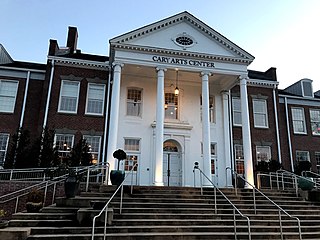
McCormick is a town in McCormick County, South Carolina, United States. As of 2024, McCormick, South Carolina population is 2,225 as of July, 2024. The population was 2,232 at the 2020 census. It is the county seat of McCormick County. The town of McCormick is named for inventor Cyrus McCormick.

Mt. Carmel is a census-designated place (CDP) in McCormick County, South Carolina, United States. The population was 379 at the 2020 census.

This is a list of structures, sites, districts, and objects on the National Register of Historic Places in North Carolina:

This is a list of the National Register of Historic Places listings in McCormick County, South Carolina.

Hampton Pinckney is a neighborhood and national historic district located in Greenville, South Carolina. One of the oldest neighborhoods in Greenville, it was where the textile industry was started in the early 19th century and lasted until the 1920s. The first trolley car in Greenville was installed in this neighborhood in 1899, opening for business in 1901.

Woodsdale–Edgewood Neighborhood Historic District is a national historic district located at Wheeling, Ohio County, West Virginia. The district encompasses 969 contributing buildings and is primarily residential, developed between 1888 and 1945. A number of popular architectural styles are represented including Shingle Style, Queen Anne, Tudor Revival, American Foursquare, Colonial Revival and Bungalow style. The district also includes four Lustron houses. Notable non-residential buildings include the Edgwood Christian Mission Alliance Church (1932), St. John's Episcopal Chapel (1913), Mount Carmel Monastery (1915) designed by Frederick F. Faris (1870-1927), and Good Shepherd Home (1912). Also located in the district are the separately listed H. C. Ogden House and William Miles Tiernan House.

The John B. McCormick House is an historic American home that is located in South Mahoning Township, Indiana County, Pennsylvania.

The Ayden Historic District is a national historic district located at Ayden, Pitt County, North Carolina. The 146-acre (59 ha) district encompasses 319 contributing buildings and six contributing structures in the town of Ayden. It includes buildings dated from the late-19th to mid-20th century and notable examples of Bungalow / American Craftsman, Colonial Revival, and Queen Anne architecture. Notable buildings include the original Ayden Town Hall (1915), Turnage Brothers Building, Moore House, John Stanley Hart House, Thelbert Worthington House (1930) designed by Leila Ross Wilburn, Ayden Baptist Church (1941), the Lloyd and Lillian Turnage House (1923) and Ayden Methodist Church (1926) designed by Benton & Benton Associates, Zion Chapel Free Will Baptist Church (1924), and Mount Olive Baptist Church.

East Home Avenue Historic District is a national historic district located at Hartsville, Darlington County, South Carolina. The district encompasses 52 contributing buildings and 1 contributing site in a primarily residential section of Hartsville. They were constructed between about 1890 to about 1938, and is associated with the leading figures of the town's history. Home Avenue has historically been the major residential street in Hartsville since it was laid out and landscaped in 1890. Architectural styles and influences include Renaissance Revival, Colonial Revival, Classical Revival, American Craftsman, and Bungalow. Notable non-residential buildings include the First Baptist Church, Thornwell Elementary School, and Hartsville Public School. Located in the district is the separately listed John L. Hart House.

St. Paul Camp Ground, also known as St. Paul A.M.E. Camp Ground, is a historic African Methodist Episcopal camp meeting and national historic district located near Harleyville, Dorchester County, South Carolina. The district encompasses 43 contributing buildings. It was established about 1880, and the buildings and grounds are used for one week each year. The tabernacle is a one-story building clad in rough-sawn weatherboard. Also on the property are 54 tents, two stores, and a storage house.

John Albert Gibert M.D. House is a historic home located near McCormick in McCormick County, South Carolina. It was built about 1867, and is a two-story, frame, I-house embellished with Greek Revival style decorative elements. It features a full-height portico supported by massive Doric order masonry columns. Also on the property is a one-story frame outbuilding, originally a single dwelling, but which later served as a general store.

McCormick County Courthouse is a historic courthouse building located at McCormick in McCormick County, South Carolina. It was designed by architect G. Lloyd Preacher and built in 1923. It is a two-story, Classical Revival style brick building. It features a large two-story portico with Doric order columns and pilasters.

Calhoun Mill, also known as Rogers Mill, is a historic grist mill located near Mount Carmel, McCormick County, South Carolina. It was built about 1860, and is a three-story, with basement, brick building. Also on the property are contributing sheds and a cotton gin, a race, and a mill dam. A mill operated on the site since the 1770s.

Long Cane Massacre Site is a historic site located near Troy, McCormick County, South Carolina. The district encompasses 40 contributing buildings in Mount Carmel. The site includes a gravestone marking the place where 23 Long Cane settlers were killed in a bloody massacre by the Cherokee on February 1, 1760.

Mount Pleasant Historic District is a national historic district located at Mount Pleasant, Charleston County, South Carolina. The district encompasses nine contributing buildings in the town of Mount Pleasant. The dwellings reflect Mount Pleasant's historic role as a summer resort town. The building reflect architectural styles of the 18th, 19th and early 20th centuries, including vernacular Georgian, Greek Revival and Gothic Revival. Notable buildings include the Mount Pleasant Presbyterian Church, St. Andrew's Episcopal Church, Mount Pleasant Seventh-Day Adventist Church, Hibben-McIver House, 200 Bank Street, and the Captain Peter Lewis House. Located in the district is the separately listed Old Courthouse.

Washington Historic District is a national historic district located at Washington, Beaufort County, North Carolina. It encompasses 512 contributing buildings and one contributing structure in the town of Washington. They include a variety of institutional, commercial, and residential buildings primarily dating from the late 19th and early 20th centuries. Notable buildings include the Beaufort County Courthouse, Havens and Fowle warehouses, Mayo Law Office, Marsh House, Myers House, Hyatt House, Griffin House, Rodman House, Elmwood, Firehouse and City Hall, Post Office and Federal Courthouse (1913), railroad station, Presbyterian church, Saint Peter's Episcopal Church, First Methodist Church (1899), Singleton Primitive Baptist Church, Blount-Bragaw Building (1901-1904), Minor House, and George T. Leach House.

Mount Airy Historic District is a national historic district located at Mount Airy, Surry County, North Carolina. The district encompasses 187 contributing buildings in the central business district and surrounding industrial and residential sections of Mount Airy. They were primarily built between about 1880 and 1930 and include notable examples of Late Victorian and Bungalow / American Craftsman architecture. Located in the district are the separately listed W. F. Carter House and Trinity Episcopal Church. Other notable buildings include the Abram Haywood Merritt House (1902), William A. Estes House, Thomas Fawcett House, J. D. Sargent House (1919), Campbell A. Baird House (1913), T. Benton Ashby House, First Baptist Church (1906-1912), Mount Airy Friends (1904), Presbyterian Church (1907-1914), Merritt Building, Banner Building (1906), Prather Block, Midkiff Hardware Store, Welch Block, West Drug Store, Belk's Building, (former) Workman's Federal Savings and Loan, (former) First National Bank (1893), Bank of Mount Airy (1923), U.S. Post Office (1932-1933), and the Sparger Brothers Tobacco Factory.

Cary Historic District is a national historic district located at Cary, Wake County, North Carolina. The district encompasses 39 contributing buildings in a predominantly residential section of Cary. The district developed between about 1890 and 1945, and includes notable examples of Queen Anne and Bungalow / American Craftsman style architecture. Notable buildings include the former Cary High School built in 1939 by the Works Progress Administration, Esther Ivey House, Captain Harrison P. Guess House, and Dr. John P. Hunter House.






















